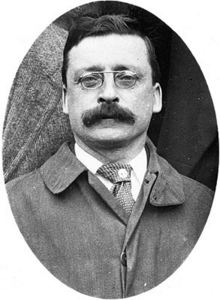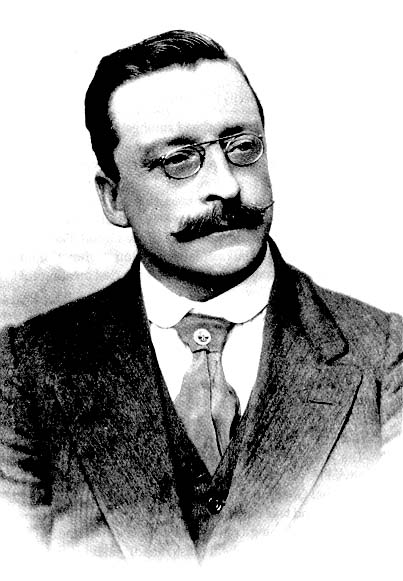<Back to Index>
- Chemist Robert Wilhelm Eberhard Bunsen, 1811
- Art Critic and Founder of the Ballets Russes Sergei Pavlovich Diaghilev, 1872
- President of Dáil Éireann Arthur Griffith, 1872
PAGE SPONSOR


Arthur Griffith (Irish: Art Ó Gríobhtha; 31 March 1872 – 12 August 1922) was the founder and third leader of Sinn Féin. He served as President of Dáil Éireann from January to August 1922, and was head of the Irish delegation at the negotiations in London that produced the Anglo-Irish Treaty of 1921.
Arthur Griffith was born at 61 Upper Dominick Street, Dublin, Ireland, on 31 March 1872, of distant Welsh lineage, and was educated by the Irish Christian Brothers.
He worked for a time as a printer before joining the Gaelic League, which was aimed at promoting the restoration of the Irish language. His father had been a printer on The Nation newspaper — Griffith was one of several employees locked out in the early 1890s due to a dispute with a new owner of the paper. The young Griffith was a member of the Irish Republican Brotherhood (IRB). He visited South Africa from 1897 to 1898, after the defeat and death of Charles Stewart Parnell whose more moderate views he had initially supported, while recovering from tuberculosis. There he supported the Boers against British expansionism and was a strong admirer of Paul Kruger.
In 1899, on returning to Dublin, he co-founded the weekly United Irishman newspaper with his associate William Rooney, who died in 1901. On 24 November 1910, Griffith married his fiancée, Maud Sheehan, after a fifteen year engagement; they had a son and a daughter.
Griffith's fierce criticism of the Irish Parliamentary Party's alliance with British Liberalism was heavily influenced by the anti-Liberal rhetoric of Young Irelander John Mitchel. Griffith combined fierce hostility to snobbery and deference with some strongly illiberal attitudes. He defended anti-semitic rioters in Limerick, denounced socialists and pacifists as conscious tools of the British Empire, and successively praised Tsarist Russia and Wilhelm II as morally superior to Great Britain.
In September 1900, he established an organization called Cumann na nGaedhael to unite advanced nationalist/separatist groups and clubs. In 1903 he set up the National Council to campaign against the visit to Ireland of King Edward VII and his consort Alexandra of Denmark. In
1907, this organization merged with Sinn Féin and a number of
others movements to form the Sinn Féin League (Irish for
"Ourselves"). In 1906, after the United Irishman journal collapsed because of a libel suit, Griffith refounded it under the title Sinn Féin;
it briefly became a daily in 1909 and survived until its suppression by
the British government in 1914, after which it was sporadically revived as the nationalist journal, Nationality. Most
historians opt for 28 November 1905, as a founding date because it was
on this date that Griffith first presented his 'Sinn Féin
Policy'. In his writings, Griffith declared that the Act of Union of Great Britain and Ireland in 1800 was illegal and that, consequently, the Anglo-Irish dual monarchy which existed under Grattan's Parliament, and the so-called Constitution of 1782 was still in effect. Its first president was Edward Martyn. The
fundamental principles on which Sinn Féin was founded were
outlined in an article published in 1904 by Griffith called The Resurrection of Hungary, in which, noting how in 1867 Hungary went from being part of the Austrian Empire to a separate co-equal kingdom in Austria-Hungary. Though not a monarchist himself, Griffith advocated such an approach for the Anglo-Irish relationship, namely that Ireland should become a separate kingdom alongside Great Britain, the two forming a dual monarchy with
a shared monarch but separate governments, as it was thought this
solution would be more palatable to the British. This was similar to
the policy of Henry Grattan a century earlier. However, this idea was never really embraced by later separatist leaders, especially Michael Collins, and never came to anything, although Kevin O'Higgins toyed with the idea as a means of ending partition, shortly before his assassination. Griffith sought to combine elements of Parnellism with
the traditional separatist approach; he saw himself not as a leader but
as providing a strategy which a new leader might follow. Central to his
strategy was parliamentary abstention: the belief that Irish MPs should refuse to attend the Parliament of the United Kingdom at Westminster, but should instead establish a separate Irish parliament (with an administrative system based on local government) in Dublin. In 1907 Sinn Féin unsuccessfully contested a by-election in North Leitrim, where the sitting MP, one Charles Dolan of Manorhamilton, County Leitrim, had defected to Sinn Féin. At this time Sinn Féin was being infiltrated by the Irish Republican Brotherhood, who saw it as a vehicle for their aims; it had several local councillors (mostly in Dublin, including W.T. Cosgrave) and contained a dissident wing grouped from 1910 around the monthly periodical called Irish Freedom.
The IRB members argued that the aim of dual monarchism should be
replaced by republicanism, and that Griffith was excessively inclined
to compromise with conservative elements (notably in his pro-employer
position during the 1913 – 1914 Dublin Lockout, when he saw the syndicalism of James Larkin as aimed at crippling Irish industry for Great Britain's benefit). In 1916 rebels seized and took over a number of key locations in Dublin, in what became known as the Easter Rising.
After its defeat, it was widely described both by British politicians
and the Irish and British media as the "Sinn Féin rebellion",
even though Sinn Féin had no involvement. When in 1917,
surviving leaders of the rebellion were released from gaol (or escaped)
they joined Sinn Féin en masse, using it as a vehicle for
the advancement of the republic. The result was a bitter clash between
those original members who backed Griffith's concept of an Anglo-Irish
dual monarchy and the new members, under Éamon de Valera, who wanted to achieve a republic. Matters almost led to a split at the party's Ard Fheis (conference) in October, 1917. In
a compromise, it was decided to seek to establish a republic initially,
then allow the people to decide if they wanted a republic or a
monarchy, subject to the condition that no member of Britain's royal
house could sit on any prospective Irish throne. Griffith resigned the
party leadership and presidency at that Ard Fheis, and was replaced by
de Valera. The leaders of the Irish Parliamentary Party (IPP) sought a rapprochement with Griffith over the British threat of conscription,
which both parties condemned, but Griffith refused unless the IPP
embraced his more radical and subversive ideals, a suggestion which John Dillon,
a leader of the IPP rubbished as unrealistic, although it would
ultimately mean the defeat and dissolution of the IPP after the
election in December 1918. Griffith was elected a Sinn Féin MP in the Cavan East by-election of mid-1918 when he asked William O'Brien to move the writ for his candidacy, and held the seat when Sinn Féin subsequently routed the Irish Parliamentary Party at the 1918 general election. In that election he was also returned for the seat of Tyrone North West. Sinn Féin's MPs decided not to take their seats in the British House of Commons but instead set up an Irish parliament, Dáil Éireann; the Irish War of Independence followed almost immediately. The dominant leaders in the new unilaterally declared Irish Republic were figures like Éamon de Valera, President of Dáil Éireann (1919 – 21), President of the Republic (1921 – 1922), and Michael Collins, Minister for Finance, head of the IRB and the Irish Republican Army's Director of Intelligence. During
de Valera's absence in the United States (1919 – 21) Griffith served as
Acting President and gave regular press interviews. He was imprisoned
in December 1920 but was subsequently released on 30 June 1921.
Griffith
became central to the Republic again when, in October 1921, President
de Valera asked him to head the delegation of Irish plenipotentiaries
to negotiate with the British government. The delegates set up
Headquarters in Hans Place,
London. After nearly 2 months of negotiations it was there, in private
conversations, that the delegates finally decided to recommend the
Treaty to the Dáil Éireann on 5 December 1921;
negotiations closed at 2.20am on 6 December 1921. Griffith was the
member of the treaty delegation most supportive of its eventual
outcome, a compromise based on dominion status,
rather than a republic. After the ratification by 64 votes to 57 of the
Anglo-Irish Treaty by the Second Dáil on 7 January 1922, he
replaced de Valera, who stepped down in protest as President of the
soon-to-be abolished Irish Republic. A vote was held on 9 January to
choose between Griffith or De Valera, which De Valera lost by 58 to 60.
A second ratification of the Treaty by the House of Commons of Southern Ireland followed shortly afterwards. Griffith was, however, to a great extent merely a figurehead as President of the second Dáil Éireann and his relations with Michael Collins, head of the new Provisional Government were somewhat tense.
Suffering
from overwork and strain after the long and difficult negotiations with
the British government, and the work involved in establishing the Free
State government, Griffith entered St. Vincent's Nursing Home, Dublin,
during the first week of August 1922, following an acute attack of
tonsilitis. He was confined to a room in St Vincent's by his doctors, who had observed signs of what they thought might be a subarachnoid hemorrhage, but it was difficult to keep him quiet, and
he resumed his daily work in the government building. He had been about
to leave for his office shortly before 10 am on 12 August 1922, when he
paused to retie his shoelace and fell down unconscious. He regained
consciousness, but collapsed again with blood coming from his mouth.
Three doctors rendered assistance, but to no avail. Father John Lee of
the Marist Fathers administered extreme unction,
and Griffith expired as the priest recited the concluding prayer. The
cause of death was reported as being due to heart failure. He died at the age of 50, ten days before Michael Collins' assassination in County Cork. He was buried in Glasnevin Cemetery four days later. The historian Diarmaid Ferriter considers
that, though he had founded Sinn Féin, Griffith was 'quickly
airbrushed' from Irish history. His widow had to beg his former
colleagues for a pension, saying that he 'had made them all'. She
considered that his grave plot was too modest and threatened to exhume
his body. Only in 1968 was a plaque fixed on his former home. Griffith Barracks which is now Griffith College Dublin on South Circular Road, Dublin, Griffith Avenue in North Dublin, Griffith Park in Drumcondra and Griffith Park in Lucan, County Dublin are named after him. The charge of anti-semitism has often been levelled at Griffith. He published articles signed by 'The Home Secretary' in his newspaper, the United Irishman, during the Dreyfus Affair which
displayed clear hatred for Jews. Even after Alfred Dreyfus had been
pardoned Griffith remained virulently Anti-Dreyfusard. He also
published Anti-Semitic material by his friends Oliver St John Gogarty and William Bulfin in both the United Irishman and Sinn Féin. Griffith's editorial support for the Limerick Pogrom (a boycott of Jewish businesses in Limerick organised by the Redemptorist Father
John Creagh in 1904) has also been criticised. His claim that it was a
boycott of usurers is weakened by the fact that the vast majority of the people affected by the boycott were tradesmen. As
his biographer Brian Maye has pointed out, Griffith clearly had a
"wildly exaggerated notion of the extent of Jewish involvement in
money lending and devious business practices" and his language was dangerously provocative. However Griffith was a close friend and associate of the Jewish solicitor Michael Noyk, who defended many IRA members in court and was himself a member of Sinn Féin.